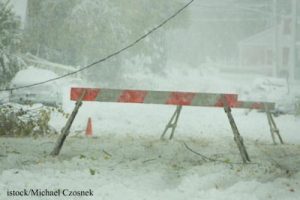A huge winter storm is approaching the Northeast United States, and may cause flooding and power outages. The FDA is offering advice to prepare for this storm and keep your food safe.
 Before the storm, make sure you have appliance thermometers in your refrigerator and freezer. The refrigerator should be set to 40°F or lower, and the freezer should be at 0°F or lower. The thermometers will help you determine if the food is safe if there is a power outage. Frozen items in a closed, well filled freezer can stay safe up to 48 hours. If the power is out for more than four hours, refrigerated food should be transferred to coolers with ice cubes or frozen gel packs.
Before the storm, make sure you have appliance thermometers in your refrigerator and freezer. The refrigerator should be set to 40°F or lower, and the freezer should be at 0°F or lower. The thermometers will help you determine if the food is safe if there is a power outage. Frozen items in a closed, well filled freezer can stay safe up to 48 hours. If the power is out for more than four hours, refrigerated food should be transferred to coolers with ice cubes or frozen gel packs.
Purchase or make ice cubes in advance and freeze gel packs ahead of time. Store these items in the freezer.
Make sure you have a supply of bottled water on hand, and store it where it will be safe from flooding. Even sealed containers can be contaminated with flood water.
If the power goes out, keep the fridge and freezer doors closed as much as possible. If you want to eat some of the foods in these appliances, make sure you cook them to safe temperatures and check them with a food thermometer. And never leave food out of refrigeration longer than two hours.
Unfortunately, it’s not safe to store perishable food outside, even in freezing temperatures. The temperature can fluctuate too much, and you can’t be sure that the food is safe when stored under these inconsistent conditions. Sunlight, for instance, can raise the temperature of food stored outside considerably. And animals can contaminate the food if it is left outside.
When the power is restored, check the temperature of both the refrigerator and freezer. If the freezer is 40°F or below, you may safely refreeze the food. But if the food doesn’t contain ice crystals or the freezer temperature is above 40°F, it is not safe to refreeze or cook that food; discard it.
Check the refrigerator and make sure that any perishable food, such as meat, poultry, fish, eggs, or leftovers is below 40°F. If it is above that temperature, and has been for more than two hours, or if you aren’t sure about the timing, throw it out.
If flooding occurs, only use water from a safe source. Use bottled water that hasn’t been exposed to any flood water. You can boil or disinfect water if you don’t have bottled water, but make sure you know what you’re doing. The water must be boiled hard for 1 minute, cooled, then stored in clean containers that have secure covers.
If you want to disinfect water with bleach, remember that this procedure will not necessarily kill all disease-causing bacteria or parasites in water. Add 1/8 teaspoon of liquid chlorine bleach to every gallon of water. Then stir it, and let stand for 30 minutes minimum before you use it. Again, store it in clean containers with covers.
Do not eat any food that has come into contact with flood waters. Discard any food or beverage that is not in a waterproof container if it has touched flood waters. Containers that are not waterproof include those with screw-on caps, snap lids, pull tops, and crimped caps. Also discard any cardboard juice/milk/baby formula boxes and home canned foods if they come into contact with flood water. Discard any food in damaged cans.
You can sanitize undamaged, commercially prepared foods in all-metal cans and retort pouches if they are washed with soap and water or boiled. Boil them for two minutes, or place in a solution of 1 tablespoon chlorine bleach for every gallon of water for 15 minutes.
And know the symptoms of foodborne illness for E. coli, Salmonella, Listeria monocytogenes, and Campylobacter. If anyone does get sick, see a doctor as soon as possible.




